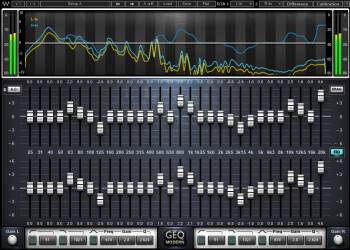An EQ changes the level of frequencies in an audio signal. It allows you to define one or more frequency bands to amplify or attenuate them. In order to achieve this, the EQ uses different filters.
Filter principle
Most filters are defined by a corner frequency, bandwidth and level (amplification/attenuation). The definition of these parameters varies depending on the filter type. Here are the most commonly used in EQs:
- The Peak filter is defined by its center frequency, bandwidth (also called Q) and level.
- The Shelving filter is defined by its cutoff frequency, level and slope (or resonance).
- The low/high-cut filter is defined by its cutoff frequency and its slope (Q) or resonance. Do note that a low-cut is also called high-pass and vice versa.
Graphic EQ
A graphic EQ splits the audio spectrum in several given frequency bands (most frequently in 15 or 31 bands) using peak filters. The center frequency and bandwidth (Q) of the filters is preset, only the level is adjustable. Graphic EQs are used mainly to process a full mix. They are very common in P.A. applications where they are used to compensate the acoustics of a venue.
Parametric or semi-parametric EQ
This type of EQ generally includes several peak filters for mid frequencies, plus shelving (or low/high cut) filters for the bottom end and the top end. An EQ is called parametric if the frequency, bandwidth (Q) and level of the peak filters are adjustable. It is called semi-parametric when the bandwidth (Q) is not adjustable.
Dynamic EQ
Much more unusual, a dynamic EQ includes filters whose setting changes depending on the input signal level or an external signal. As a consequence, you’ll have to set each parameter for both filter states: the initial state, when the signal level stays below the given threshold; and the target state, when the signal level exceeds that threshold.
What should I use and when?
As already mentioned before, graphic EQs are mainly used to process signals across the whole frequency spectrum. For a finer and more precise EQing, you should rather use a parametric EQ. Here are a couple of standard examples:
- Use a graphic EQ to adjust a P.A. or studio monitoring system according to the room acoustics
- Use a low/high cut filter to clean out the low-frequency or high-frequency noise
- Use shelving filters to limit each instrument to a given frequency band
- Use an extremely narrow peak filter (called notch filter) to suppress feedback
- Use a peak filter to attenuate an unwanted resonance
- Use a shelving filter to add air to the sound
- Use a dynamic filter to create an auto-wah effect
- Use a dynamic filter to emphasize/attenuate the brightness of a source depending on its level


